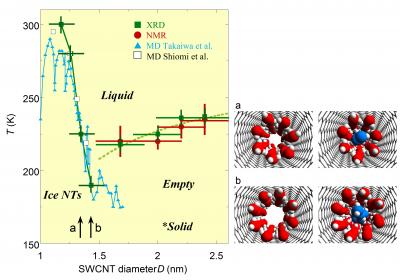A research team from Japan has discovered amazing facts regarding the phase behavior of confined water within the carbon nanotubes’cylindrical pores. The discoveries made by the researchers from Nagoya University, Tokyo Metropolitan University, National Institute of Advanced Industrial Science and Technology, and Japan Science and Technology Agency are published in the Journal of Chemical Physics by the American Institute of Physics.
 Confined water within the cylindrical pores of carbon nanotubes
Confined water within the cylindrical pores of carbon nanotubes
Although carbon nanotubes comprise graphene sheets, which are water repellent (hydrophobic) in nature, investigations on single-walled carbon nanotubes (SWCNTs) depict that water can very well be confined in open-ended carbon nanotubes. This finding which explores t nanoconfined water properties within SWCNTs pores, lays a platform for nanoscience in the future.
It is expected that carbon nanotubes having nanoconfined water will enable the creation of several nanodevices such as molecular nanovalves, nanoscale power cells, nanofiltration systems, nanoscale ferroelectric devices, and molecular water pumps.
Yutaka Maniwa, Physics’s professor, Tokyo Metropolitan University stated that due to nanoconfinement effect, strange properties are exhibited which otherwise remain unobserved. Nanoconfinement effect is defined as the impact caused by confining materials at the atomic scale, For instance, in geology, nanoconfined water creates the driving force that forms frost heaves in soil and makes clay minerals to swell. Such kind of water effects was experimentally found using SWCNTs, he added.
When temperature decreases, water at 1.68 to 2.40 nm range within SWCNTs experiences a wet-dry mode of transition. When SWCNTs are very narrow, tubule ices are formed by the inside water, that are different from the ices formed so far. In contrast to the bulk water within a large-diameter capillary, the melting point of water increases with decrease in SWCNT diameter. Even at room temperature, tubular ice was formed inside SWCNTs.
These results help in better understanding of fundamental science as nanoconfined water occupy an important place and exist everywhere, even in human beings. Exploring the properties of nanoconfined materials is critical in developing new devices such as nanofiltration and proton-conducting membranes, suggested Maniwa.
Source: http://www.jcp.aip.org